
Juniperus excelsa, commonly called the Greek juniper, is a juniper found throughout the eastern Mediterranean, from northeastern Greece and southern Bulgaria across Turkey to Syria and Lebanon, Jordan and the Caucasus mountains.

Xanthone is an organic compound with the molecular formula O[C6H4]2CO. It is a white solid.

Searsia pyroides, previously known as Rhus pyroides, is a species of Searsia, native to southern Africa. This tree occurs throughout the whole of South Africa, a part of Botswana, Zimbabwe and Tanzania and in some areas of Namibia near Windhoek.

Juniperus procera is a coniferous tree native to mountainous areas in Africa and the Arabian Peninsula. It is a characteristic tree of the Afromontane flora.

Aphloia is a genus of flowering plants that contains a single species, Aphloia theiformis, the sole species of the monogeneric family Aphloiaceae. It is a species of evergreen shrubs or small trees occurring in East Africa, Madagascar, the Mascarene Islands and the Seychelles.
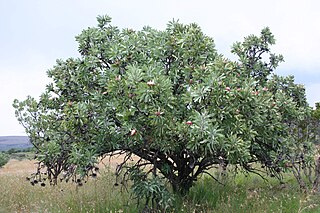
Protea caffra, native to South Africa, is a small tree or shrub which occurs in open or wooded grassland, usually on rocky ridges. Its leaves are leathery and hairless. The flower head is solitary or in clusters of 3 or 4 with the involucral bracts a pale red, pink or cream colour. The fruit is a densely hairy nut. The species is highly variable and has several subspecies.
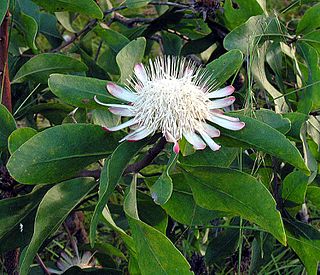
Protea gaguedi is a species of tree which belongs to the genus Protea.

Uapaca kirkiana, the sugar plum or mahobohobo, is a species of dioecious plant in the family Phyllanthaceae. It is native to the southern Afrotropics, where it occurs in well-watered miombo woodlands. Within range it is one of the most popular wild fruits. It is rarely cultivated but trees are left when land is being cleared. Still a traditional food plant in Africa, this little-known fruit has the potential to improve nutrition, boost food security, foster rural development and support sustainable land care.

Ehretia rigida, is a small, multi-stemmed tree with a tangled growth habit belonging to the Boraginaceae, the borage family. It occurs over a wide range of habitat throughout the eastern part of South Africa, and in Namibia, Botswana, Zimbabwe and Mozambique.

The exodermis is a physiological barrier that has a role in root function and protection. The exodermis is a membrane of variable permeability responsible for the radial flow of water, ions, and nutrients. It is the outer layer of a plant's cortex. The exodermis serves a double function as it can protect the root from invasion by foreign pathogens and ensures that the plant does not lose too much water through diffusion through the root system and can properly replenish its stores at an appropriate rate.
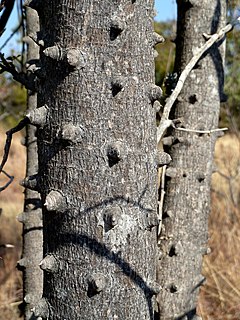
Zanthoxylum capense, the small knobwood, is a species of plant in the family Rutaceae. It occurs in the eastern regions of southern Africa, from the vicinity of Knysna, Western Cape to the Zimbabwean granite shield and coastal Mozambique. It tolerates a range of altitudes, from highveld to coastal elevations, but is most prevalent in dry thickets or on rocky slopes and outcrops.
Guibourtia conjugata is a species of small to medium sized trees from family Fabaceae that can be found in Mozambique, Zambia and Zimbabwe. The plants are growing in woods and along the river banks of Limpopo and Mpumalanga. The plant is 9 meters tall, with the leaves that can range from 3–5 cm in length and are ovated and a bit curved. The plant's flowers are either white or yellow coloured and are 5 mm in diameter. Their apex is rounded and is hairless.

Hypericum revolutum is a shrub or small tree in the genus Hypericum native to Arabia and Africa. It is evergreen, with leaves opposite, closely spaced and crowded at the ends of branches, c. 20 × 5 mm, green to slightly glaucous, sessile, clasping at the base. Single bright yellow flowers form at the ends of branches, up to 5 cm in diameter, blooming from June to November. Fruit is a reddish-brown capsule, up to 13 × 10 mm.
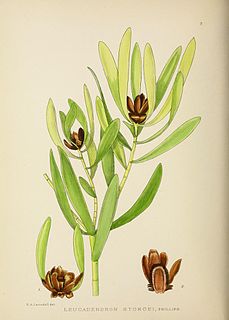
Leucadendron microcephalum is a dioecious, single-stemmed, South African shrub belonging to the family Proteaceae, endemic to the Western Cape and growing from sea level to 1200 m. It is one of some 200 species in the genus, all confined to South Africa.

Euphorbia schinzii is a perennial Southern African, dwarf flowering plant belonging to the family Euphorbiaceae. It is found on rocky slopes, growing among rocks. Variable in form, it occurs in South Africa, Zimbabwe, Botswana, Mozambique and Malawi, at an altitude between 100 and 1500 meters. The genus Euphorbia is large, with over 2000 species of extremely diverse size and appearance, and with a global distribution.

Hypericum ericoides is a dwarf shrub in the flowering plant family Hypericaceae, section Coridium. It is found in eastern and southeastern Spain, Morocco, and Tunisia. Its preferred habitat is fissures in calcareous rocks in warm, sunny places, from 200 to 2,000 meters above sea level (MASL).

Leucospermum saxosum is an upright evergreen shrub of up to 2 m (6.6 ft) high, that is assigned to the family Proteaceae. It has lance-shaped, leathery leaves and egg-shaped flower heads of about 5 cm (2.0 in) in diameter, with initially yellow-orange flowers, later turning crimson, from which long styles stick out, giving the flower head the appearance of a pincushion. It is called escarpment pincushion in English. It grows on quartzite soils in the mountains on the Zimbabwe-Mozambique border and in eastern Transvaal.
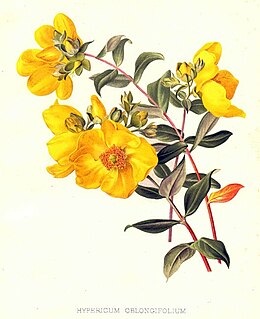
Hypericum oblongifolium, known as Pendant St. John's wort, is a species of flowering plant in Hypericumsect. Ascyreia.

Microcoelia exilis, commonly known as the pinhead orchid, is a species of flowering plant in the orchid family, Orchidaceae. It is a leafless epiphyte, a perennial herb that grows in a tangled cluster of roots and stems on the branch of a tree. This orchid is native to tropical central and eastern Africa and was first described in 1830 by the English botanist John Lindley.
Protea dracomontana, the Nyanga protea or the Drakensberg sugarbush, is a flowering plant that belongs within the genus Protea. The plant is found in the Eastern Cape, Lesotho, KwaZulu-Natal and the escarpment of the Free State, as well as eastern Zimbabwe. In Zimbabwe this species is only known from a disjunct subpopulation confined to the summit of Mount Nyangani.




















